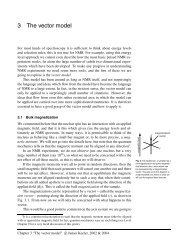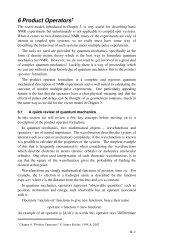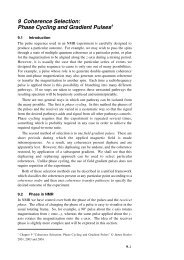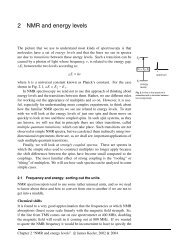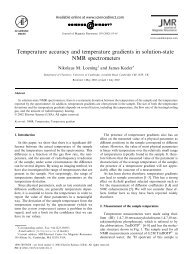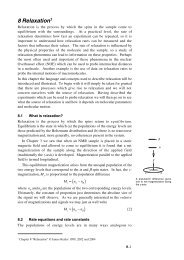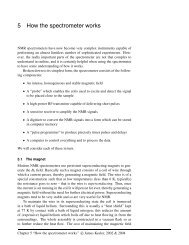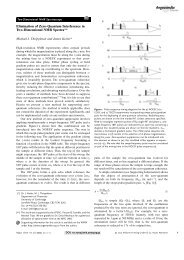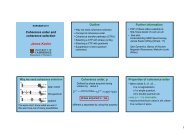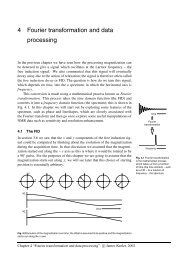Phase Cycling and Gradient Pulses - The James Keeler Group
Phase Cycling and Gradient Pulses - The James Keeler Group
Phase Cycling and Gradient Pulses - The James Keeler Group
You also want an ePaper? Increase the reach of your titles
YUMPU automatically turns print PDFs into web optimized ePapers that Google loves.
<strong>and</strong> then combined in the manner described in section 9.4.4.2 to give a<br />
frequency discriminated absorption mode spectrum.<br />
In the case that I <strong>and</strong> S are proton <strong>and</strong> carbon-13 respectively, the gradients<br />
G 1<br />
<strong>and</strong> G 2<br />
are in the ratio 2:±1. Proton magnetization not involved in<br />
heteronuclear multiple quantum coherence, i.e. magnetization from protons not<br />
coupled to carbon-13, is refocused after the second gradient G 1<br />
but is then<br />
dephased by the final gradient G 2<br />
. Provided that the gradient is strong enough<br />
these unwanted signals, <strong>and</strong> the t 1<br />
-noise associated with them, will be<br />
suppressed.<br />
9.6.7.4 HSQC<br />
I<br />
∆<br />
2<br />
∆<br />
2<br />
y<br />
a<br />
∆<br />
2<br />
∆<br />
2<br />
t 2<br />
S<br />
t 1<br />
b<br />
g<br />
1<br />
p I 0<br />
–1<br />
1<br />
p S 0<br />
–1<br />
G<br />
<strong>The</strong> sequence above shows the simplest way of implementing gradients into the<br />
HSQC experiment. An analysis using product operators shows that at point a<br />
the required signal is present as the operator 2I z<br />
S z<br />
whereas the undesired signal<br />
(from I spins not coupled to S spins) is present as I y<br />
. Thus, a field gradient<br />
applied at point a will dephase the unwanted magnetization <strong>and</strong> leave the<br />
wanted term unaffected. This is an example of using gradients not for<br />
selection, but for suppression of unwanted magnetization (see section 9.6.3.2).<br />
<strong>The</strong> main practical difficulty with this approach is that the unwanted<br />
magnetization is only along y at point a provided all of the pulses are perfect; if<br />
the pulses are imperfect there will be some z-magnetization present which will<br />
not be eliminated by the gradient. In the case of observing proton- 13 C or<br />
proton- 15 N HSQC spectra from natural abundance samples, the magnetization<br />
from uncoupled protons is very much larger than the wanted magnetization, so<br />
even very small imperfections in the pulses can give rise to unacceptably large<br />
residual signals. However, for globally labelled samples the degree of<br />
suppression is often sufficient <strong>and</strong> such an approach is used successfully in<br />
many three- <strong>and</strong> four-dimensional experiments applied to globally 13 C <strong>and</strong> 15 N<br />
labelled proteins.<br />
<strong>The</strong> key to obtaining the best suppression of the uncoupled magnetization is<br />
to apply a gradient when transverse magnetization is present on the S spin. An<br />
example of the HSQC experiment utilising such a principle is shown below<br />
9–46



